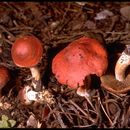en
names in breadcrumbs


Der Orangerote Träuschling (Leratiomyces ceres, Syn.: Stropharia aurantiaca) ist eine Pilzart aus der Gattung Leratiomyces.
Der Orangerote Träuschling bildet 2–5 cm breite Hüte mit schleimiger Huthaut und spärlichen weißen Schüppchen am Hutrand. Die Hutform ist zunächst halbkugelig, später gewölbt-abgeflacht mit einem Buckel. Die Hutoberfläche ist orange bis blutrot gefärbt. Der Stiel ist schlank, bis 10 cm lang und 1 cm breit, weißlich bis gelblich ohne Ring, lediglich bei jungen Exemplaren kann ein flüchtiger Velumgürtel vorhanden sein. Der untere Teil des Stiels ist faserschuppig, bei älteren Exemplaren wird der Stiel orangebräunlich. Die jung weißlich-gelben, später olivbräunlichen Lamellen sind ausgebuchtet am Stiel angeheftet. Das Sporenpulver ist rötlich braun.
Der Orangebraune Träuschling ist ein saprobiontischer Holzzersetzer, der an vergrabenem Holz, Holzhäcksel und ähnlichen Substraten in Laub- und Mischwäldern, Hainen, Gärten und Parks wächst. Seine Fruchtkörper erscheinen in Mitteleuropa etwa von September bis November.
Der Orangerote Träuschling war früher Teil der Gattung der Träuschlinge (Stropharia), wurde jedoch aufgrund genetischer Untersuchungen in die Gattung Leratiomyces überführt.[1]
Der Orangerote Träuschling ist eine europäische Art, die von Spanien, den Balearen, Korsika und Italien über Frankreich und die Niederlande bis Großbritannien vorkommt. Nach Deutschland, wo die Art selten zu finden ist, wurde sie wahrscheinlich von Nordwesten her eingeschleppt, es wird angenommen, dass sie hier in Ausbreitung begriffen ist.
Kein Speisepilz.
Der Orangerote Träuschling (Leratiomyces ceres, Syn.: Stropharia aurantiaca) ist eine Pilzart aus der Gattung Leratiomyces.
Leratiomyces ceres,[1] commonly known as the Redlead Roundhead, is mushroom which has a bright red to orange cap and dark purple-brown spore deposit. It is usually found growing gregariously on wood chips and is one of the most common and most distinctive mushrooms found in that habitat.[1][2] It is common on wood chips and lawns in North America, Europe, Australia, New Zealand and elsewhere.[1] The name Stropharia aurantiaca has been used extensively but incorrectly for this mushroom (together with a number of similar synonyms).
L. ceres may be described as follows.[3][4]
There has been some confusion between L. ceres, which has a fairly thick white stem, and L. squamosus var. thaustus, which has a slender stem and prominent scales below the ring zone (although the two taxa are quite easy to distinguish by sight). Around 1885 Mordecai Cubitt Cooke originated the names Agaricus squamosus f. aurantiacus and Agaricus thraustus var. aurantiacus, and this later gave rise to the name Stropharia aurantiaca.[7] This name is defined by Cooke's illustration to his Handbook of British Fungi and in 2004 Richard Fortey discovered that this illustration was not of L. ceres, as had generally been assumed,[3] but it was L. squamosus var. thaustus.[8] Thus the name aurantiaca is best avoided, being wrong when applied to L. ceres.
The name Agaricus ceres was created in 1888 by Cooke and Massee for the white-stemmed species, and was reclassified as Psilocybe ceres (in 1891) and Leratiomyces ceres (in 2008).[9][3]
Similar species include L. squamosus,[6] Agrocybe putaminum, Gymnopilus sapineus, Psathyrella gracilis,[5] Stropharia squamosa, S. thrausta,[6] and Tubaria furfuracea.[5]
In psilocybin mushroom hunting communities in Australia and New Zealand, L. ceres (or "Larrys" as commonly nicknamed) are scorned as lookalikes and imposters of Psilocybe species on wood chip. Prolific growth in the same habitats and a similar appearance from afar can give false hope of a large bounty, but on closer inspection the species are not particularly alike.
Leratiomyces ceres, commonly known as the Redlead Roundhead, is mushroom which has a bright red to orange cap and dark purple-brown spore deposit. It is usually found growing gregariously on wood chips and is one of the most common and most distinctive mushrooms found in that habitat. It is common on wood chips and lawns in North America, Europe, Australia, New Zealand and elsewhere. The name Stropharia aurantiaca has been used extensively but incorrectly for this mushroom (together with a number of similar synonyms).
Leratiomyces ceres
La Strophaire orangée (Leratiomyces ceres synonyme : Stropharia aurantiaca) est une espèce de champignons de la famille des Strophariaceae.
Leratiomyces ceres
La Strophaire orangée (Leratiomyces ceres synonyme : Stropharia aurantiaca) est une espèce de champignons de la famille des Strophariaceae.
Capel fin a 6 cm, tachiss, vermèj o vinos. Bòrd con fiòch bianch giaunastr. Lamele uliva ciàir peui brun porporà. Fil rusià. Gamba àuta fin a 10 cm e larga fin a 1 cm, bianca o òcra, fibrilos-marcà. Anel fràgil.
A chërs ëdzora a la paja, la rëssiura e via fòrt.
![]() A venta mai mangé un bolè trovà se un a l'é nen un bon conossidor dij bolè!
A venta mai mangé un bolè trovà se un a l'é nen un bon conossidor dij bolè!
Sensa anteresse alimentar.
Stropharia aurantiaca (Cooke) Imai
Capel fin a 6 cm, tachiss, vermèj o vinos. Bòrd con fiòch bianch giaunastr. Lamele uliva ciàir peui brun porporà. Fil rusià. Gamba àuta fin a 10 cm e larga fin a 1 cm, bianca o òcra, fibrilos-marcà. Anel fràgil.
AmbientA chërs ëdzora a la paja, la rëssiura e via fòrt.
Comestibilità![]() A venta mai mangé un bolè trovà se un a l'é nen un bon conossidor dij bolè!
A venta mai mangé un bolè trovà se un a l'é nen un bon conossidor dij bolè!
Sensa anteresse alimentar.
| fotkaraktär = ring | sporavtrycksfärg = brun }}
Leratiomyces ceres je grzib[4], co go nojprzōd ôpisoł Cooke & Massee, a terŏźnõ nazwã doł mu Spooner & Bridge 2008. Leratiomyces ceres nŏleży do zorty Leratiomyces i familije Strophariaceae.[5][6] Żŏdne podgatōnki niy sōm wymianowane we Catalogue of Life.[5]
| fotkaraktär = ring | sporavtrycksfärg = brun }}
Leratiomyces ceres je grzib, co go nojprzōd ôpisoł Cooke & Massee, a terŏźnõ nazwã doł mu Spooner & Bridge 2008. Leratiomyces ceres nŏleży do zorty Leratiomyces i familije Strophariaceae. Żŏdne podgatōnki niy sōm wymianowane we Catalogue of Life.